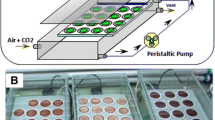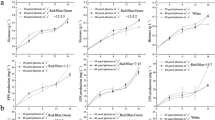Abstract
To probe the effects of renewal regime on the production of polysaccharides, Porphyridium cruentum was cultured semi-continuously in flat plate photobioreactor. Uniform design was used to optimize renewal conditions. Quadratic mathematic models related to productivity, total recovery yield of biomass and polysaccharides were set up to clarify the influence of individual factors and their interactions. According to the mathematic models, the optimal semi-continuous condition for total yield of polysaccharide was NaNO3 3.5 g/L, renewal rate 27%, renewal period 2.91 days. The optimal condition for polysaccharide output rate was NaNO3 0.5 g/L, renewal rate 5%, renewal period 7 days. With the optimal renewal regime, the maximal total recovery yields of polysaccharide achieved at 29.4 g, which was 1.57 times higher than that of batch cultivation. The maximum output rate of polysaccharide was 68.64 mg/L per day, which was 2.02 times higher than previous reported data.




Similar content being viewed by others
References
You T, Barnett SM (2004) Effect of light quality on production of extracellular polysaccharides and growth rate of Porphyridium cruentum. Biochem Eng J 19:251–258
Geresh S, Adin I, Yarmolinsky E, Karpasas M (2002) Characterization of the extracellular polysaccharides of Porphyridium sp.: molecular weight determination and rheological properties. Carbohydr Polym 150:183–189
Mahmoud A, Vladimir Z, Jacov T, Arad SS (2002) Activity of Porphyridium sp polysaccharide against herpes simplex viruses in vitro and in vivo. Biochem Biophys Meth 50:189–200
Liu XC, Vonshak A (2004) Modified responses of Porphyridium sp cells with an inxreased polysaccharide level to stress. Guangdong Plant 2:166–173
Gu NY, Liu YF (2002) Bioactive substances of Porphyridium and their applications. J China Mar Medicat 6:43–48
Wang J, Chen BL, Rao XZ (2007) Optimization of culturing conditions of Porphyridium cruentum using uniform design. World J Microbiol Biotechnol 6:117–123
Joung HY, Sung JK, Ahn SH, Lee HK (2003) Optimal conditions for the production of sulfated polysaccharide by marine microalga Gyrodinium impudicum strain KG03. Biomol Eng 20:273–280
Chen BL, Liang SZ, Wang J (2004) Optimization cultural conditions of Porphyridium cruentum in the stirred photobioreactor. J Fujian Normal Univ Nat Sci Edition 2:91–96
Arad MS, Brown SY, Dubinsky O (1992) Effect of nitrate and sulfate starvation on polysaccharide production in Rhodella reticulate. Bioresour Technol 42:141–143
Fabregas J, Garcia D, Morales E et al (1998) Renewal rate of semicontinuous cultures of the microalga Porphyridium cruentum modifies phycorythrin, exopolysaccharide and fatty acid productivity. J Ferment Bioeng 86:477–481
Zhu YF, Lin X, Xu TC et al (2004) Effects of light intensity, concentration of nitrogen and renewal rate in semicontinuous cultures on growth and recovery yield of Nanochloropsis oculate (Droop) Hibberd. J Fish Sci China 11:159–164
Otero A, Fabregas J (1997) Changes in the nutrient composition of Tetraselmis suecica cultured semicontinuously with different nutrient concentrations and renewal rate. Aquaculture 159:111–123
Otero A, Garcia D, Morales ED et al (1997) Manipulation of the biochemical composition of the eicosapentaenoic acid rich microalga Isochrysis galbana in semixontinuous cultures. Biotechnol Appl Biochem 26:171–177
Singh S, Arad SM, Richmond A (2000) Extracellular polysaccharide production in outdoor mass cultures of Porphyridium sp in flat plate reactors. J Applied Phycol 12:269–275
Sun LQ, Lin J, Wang CH (2004) Application of uniform design in the media optimization of Porphyridium cruentum. J Mar Sci Bull 23:23–29
Zhang WJ (2003) Saccharide complex biochemical research technology. Zhejiang University Press, Hangzhou, pp 11–12
State Environmental Protection Administration (1989) Inspect and analysis methods of water and waste water. China Environmental Science Press, Beijing, China, pp 278–280
Zeng SJ (2005) Uniform design and its application. Medicine Technology Press, Beijing, p 122
Shi L (2008) Optimization of culture conditions for Porphyridium cruentum in the flat plate photobioreactors. Master Dissertation submitted to Yantai University, pp 31–33
Maria A, Guzman M, Claudia C et al (2007) Effects of fertilizer-based culture media on the production of exocellular polysaccharides and cellular superoxide dismutase by Phaeodactylum tricornutum (Bohlin). J Appl Phycol 19:33–41
Otero A, Dominguez A, Lamela T et al (1998) Steady-states of semicontinuous cultures of a marine datom: effect of saturating nutrient concentrations. J Exp Mar Biol Ecol 227:233–234
Zhang DL, He PM, Zhou HQ (1999) Experiment on different culture methods of Chlorella spp. J Shanghai Fish Univ 8:1–5
Zhu YF, Wu SJ, Guo XQ (2000) Effects of nitrogen, phosphorus concentration and renewal rate on recovery yields of Phaeodactylum tricornutum in semicontinuous cultures. Mar Sci 24:35–38
Hernandez CJ, Cass-Valdez M, Ortega-Garcia S (2000) Effect of climatic variation on the relative abundance of red alga Gelidium robustus in Baja Califormia Sur, Mexico. J Appl phycol 177:177–188
Acknowledgments
We are thankful to the Natural Science-Foundation of Province Shandong, China (No. Y2007D59) for the financial support.
Author information
Authors and Affiliations
Corresponding author
Rights and permissions
About this article
Cite this article
Sun, L., Wang, C., Ma, C. et al. Optimization of renewal regime for improvement of polysaccharides production from Porphyridium cruentum by uniform design. Bioprocess Biosyst Eng 33, 309–315 (2010). https://doi.org/10.1007/s00449-009-0325-x
Received:
Accepted:
Published:
Issue Date:
DOI: https://doi.org/10.1007/s00449-009-0325-x




